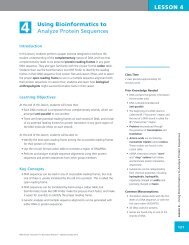WET LAB DNA Barcoding: From Samples to Sequences - Northwest ...
WET LAB DNA Barcoding: From Samples to Sequences - Northwest ...
WET LAB DNA Barcoding: From Samples to Sequences - Northwest ...
You also want an ePaper? Increase the reach of your titles
YUMPU automatically turns print PDFs into web optimized ePapers that Google loves.
<strong>WET</strong> <strong>LAB</strong><br />
Wet Lab: Slide #2<br />
Polymerase chain reaction (PCR):<br />
A scientific technique in molecular<br />
biology used <strong>to</strong> amplify (i.e., copy) a<br />
single or a few copies of a piece of <strong>DNA</strong><br />
across several orders of magnitude,<br />
generating thousands <strong>to</strong> millions of<br />
copies of a particular <strong>DNA</strong> sequence.<br />
Using Bioinformatics: Genetic Research<br />
Agarose gel electrophoresis:<br />
Electrophoresis refers <strong>to</strong> the process of<br />
using an electric field <strong>to</strong> move molecules<br />
through a gel matrix. In the case of <strong>DNA</strong>,<br />
agarose is used <strong>to</strong> form the gel matrix,<br />
and the electrical current separates <strong>DNA</strong><br />
fragments based on size, with smaller<br />
(or lower molecular weight) fragments<br />
moving <strong>to</strong> the positive electrode more<br />
quickly than larger fragments.<br />
PCR purification: Extracting or purifying<br />
the PCR product (<strong>DNA</strong> fragment) away<br />
from the remaining PCR components.<br />
<strong>DNA</strong> sequencing: The process of<br />
determining the identity and order of<br />
bases in a molecule of <strong>DNA</strong>.<br />
Detergents: Substances (for example,<br />
soap), that contain both hydrophobic and<br />
hydrophilic regions, used <strong>to</strong> dissolve lipids<br />
(i.e., cell membranes).<br />
Cell membrane: Phospholipid bilayer<br />
surrounding the cell.<br />
Spin columns: A small column that fits<br />
inside of a microfuge tube and contains a<br />
material (such as silica) that binds <strong>to</strong> nucleic<br />
acids such as <strong>DNA</strong>. The spin column is<br />
used in conjunction with centrifugation (or<br />
vacuum pressure) <strong>to</strong> purify <strong>DNA</strong>.<br />
Centrifugal force: The apparent force<br />
that seems <strong>to</strong> pull an object outward when<br />
the object is spun around in a circle.<br />
Elute: To extract or remove one material<br />
from another, often by adding a solvent<br />
such as a buffer.<br />
3. Show Slide #2, “<strong>From</strong> <strong>Samples</strong> <strong>to</strong> <strong>Sequences</strong>.” Tell students that they<br />
will be performing a series of labora<strong>to</strong>ry experiments. These are the same<br />
experiments that genetic researchers perform every day.<br />
a. Obtain samples from the species they will be studying.<br />
b. Perform <strong>DNA</strong> purification, which is Lab 1, and is the focus of this first<br />
two-day experiment.<br />
c. Copy the <strong>DNA</strong> barcoding gene, COI, using the polymerase chain<br />
reaction (PCR), which is Lab 2.<br />
d. Confirm PCR results using agarose gel electrophoresis (Lab 3).<br />
e. Prepare samples for <strong>DNA</strong> sequencing by performing a PCR purification<br />
experiment (Lab 4) and submit the samples <strong>to</strong> a <strong>DNA</strong> sequencing facility.<br />
4. Show Slide #3, “<strong>DNA</strong> Purification Overview,” and review with students the<br />
steps involved in purifying <strong>DNA</strong>:<br />
a. First, break open the cells. This is done by chopping the tissues<br />
in<strong>to</strong> tiny pieces and adding detergents (which break down the cell<br />
membranes) and heat.<br />
b. Second, separate the <strong>DNA</strong> from the rest of the cell debris. Genetic<br />
researchers use something called a spin column, which contains a<br />
membrane made of material (such as silica) that has an affinity for <strong>DNA</strong>.<br />
The <strong>DNA</strong> binds <strong>to</strong> the membrane in the spin column, and the remaining<br />
cell debris washes through the tiny holes in the membrane when the spin<br />
column is subjected <strong>to</strong> centrifugal force in a microcentrifuge.<br />
c. Finally, elute (remove) the <strong>DNA</strong> from the column using a buffer. The buffer<br />
changes the pH in the spin column and causes the <strong>DNA</strong> <strong>to</strong> no longer bind<br />
<strong>to</strong> the spin column. This buffer will also keep the <strong>DNA</strong> stable for future use.<br />
326<br />
©<strong>Northwest</strong> Association for Biomedical Research—Updated Oc<strong>to</strong>ber 2012
















